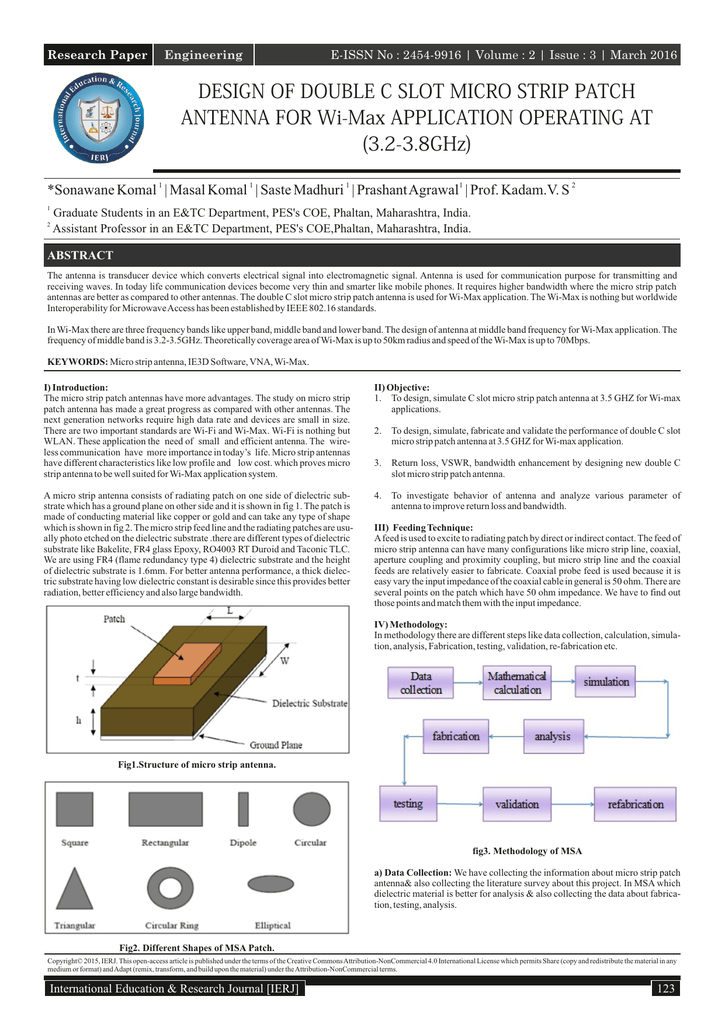

Publishing House of Science, Beijing (2008) (in Chinese) Liu, J.-Y.: The Principles and Methods for GPS satellite navigation, 2nd edn.

Microstrip antenna theory and application xidian university Patch#
Compared with the conventional GPS microstrip antenna with the same material, the characteristics of the proposed antenna are enhanced, the whole size is reduced, the area of the radiating patch is reduced by 26%, meanwhile,the cost of the antenna’s substrate material is low, which satisfies with the requirements of GPS receiver for miniaturization, low-cost and compactness.

The simulated results indicate that the impedance matching is excellent, the antenna has the characteristic of wide-angle circular polarization, and the radiation patterns of RHCP are excellent In a wide elevation angle range, the RHCP level is at least 15dB higher than that of LHCP, which has a good suppression of interference from cross-polarization and multipath effect. The miniaturization and the right-hand circular polarization (RHCP) is obtained through a square-ring patch and truncated corners in which, respectively. Reconfigurable Antenna Laboratory, University of TorontoĪdvanced Electromagnetic Surfaces Reconfigurable Space Fed Arrays Wideband Planar Apertures Multi-beam Multi-polarization Apertures Multi-function Antennas Reconfigurable Antennas for MIMO Frequency-Agile Antennas Handset Antennas Based on Characteristic Modes Vehicular Antennas Antennas for Space Transparent Solar Antennas Deployable AntennasĪpplied Electromagnetics Laboratory, University of ManitobaĪssistance to Industry with Antenna Design.The design of a microstrip antenna which operates at the GPS L1 band is presented in this paper. Nanophotonics and Integrated Optoelectronics Lab Integrated Quantum Optoelectronics Lab Centre for Integrated RF Engineering (CIRFE) Lab Emerging Radio System Group Centre for Intelligent Antenna and Radio Systems (CIARS)Ĭentre for Intelligent Antenna and Radio Systems (CIARS), University of Waterlooīioelectromagnetics Computational Electromagnetics Electromagnetic Inverse Scattering and Imaging Energy Harvesting Graphene-based Structures Low-cost Integrated Phased Array Antennas Millimeter-wave sensing Optics and Photonics Scanned Beam Antenna for Aerospace Application Silicon-based Structures for mm/THz Applications Terahertz Absorption Spectroscopy Vehicular Centric Communication and Sensing Network Wearables and IOT Metasurfaces Leaky-wave Antennas Spacetime Metamaterials Magnetles Nonreciprocity Quantum Metamaterials Optical Forces Manipulation Thermal Radiation EngineeringĪntennas, Microwaves, and Wave Optics, University of Waterloo META Research Group, KU Leuven (Moving from École Polytechnique de Montréal, Canada)

Antennas at Millimeter Wave Frequencies, Electronic Beam Steering, and Small Integrated Antennas Metasurfaces Centimeter-Wave Radar RadioAstronomy Arrays Metamaterials Antennas for Planetary Observation Ultra-Wideband Positioning Real-Time Polarimetric RFID Tracking Urban Propagation Acoustic Brain Stimulation Scattering by Large Moving Objects Phased Arrays for 5G Communications Antenna Arrays on Finite Platforms Metamaterials for Ultra-High Field MRIĮM Theory & Antennas, Telecommunications and Microwaves, KU Leuvenĭevelopment and Application of Fundamental and Computational Electromagnetics. Reconfigurable antennas Base station antennas Metamaterial-inspired antennas Metasurface-based antennas Electrically small antennas Non-Foster circuit augmented antennas Rectennnas Antenna arrays Reflector antennas and feed horns RF filters and matching circuits Microwave and mm-wave IC designīelarusian State University of Informatics and RadioelectronicsĪntenna Group, Université catholique de Louvain Radio Frequency and Antennas, RMIT University, MelbourneĮlectromagnetic Informatics Lab, University of Technology (UTS), Sydney If you wish to add your group added to the list, please provide evidence in the form of a link to their antennas research group, and some links to papers their staff have published in journals such as those from the IEEE - not just conference proceedings. The following groups do significant amounts of research into antennas, rather than just the odd paper here and there.


 0 kommentar(er)
0 kommentar(er)
